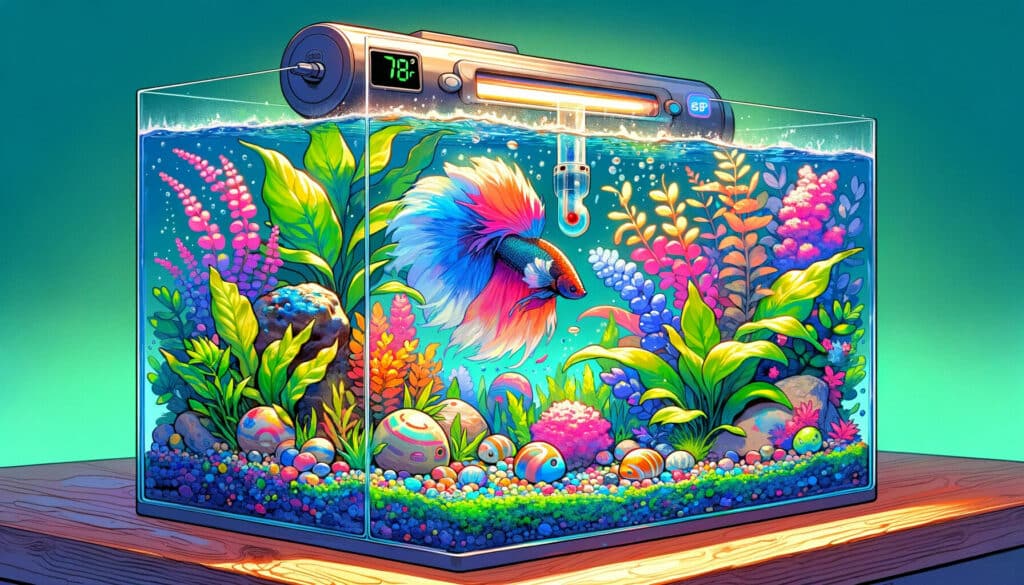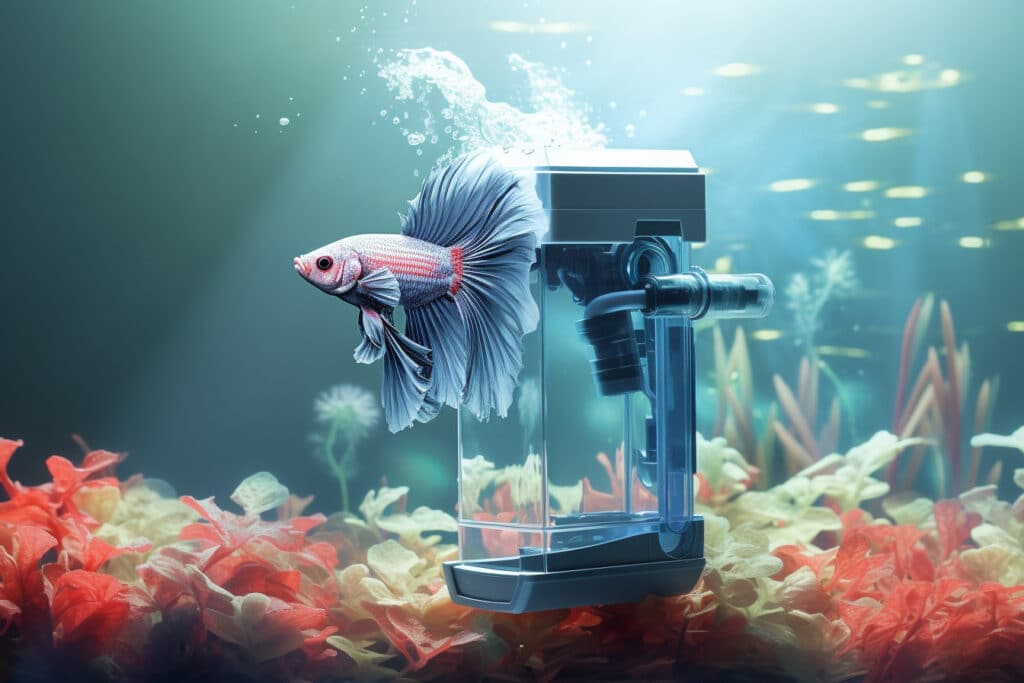How To Clean A Betta Fish Tank The Best Way
Welcome to our Blog post about “How To Clean a Betta Fish Tank”

We all love the vibrant colors and flowing fins of our little aquatic friends, but to keep them looking their absolute best, a clean and healthy tank is essential.
You wouldn’t like living in a messy room, would you? Well, neither does your betta fish! A clean tank not only makes your fish happier but also ensures they live a long and healthy life.
In this article, we’re diving deep into the fascinating world of Betta fish tank cleanliness. From spotting the tell-tale signs that scream “Clean me!” to a step-by-step guide on making your tank sparkle, we’ve got you covered.
By the end of this read, you’ll be equipped with all the know-how you need to keep your tank in tip-top shape, ensuring your betta fish feels like the royalty they truly are! So grab your sponges and nets; it’s cleaning time!
Table of Contents 🦑
Preparation Steps: Gear Up for Cleaning Success!
Before you unleash your inner cleaning guru, you’ll want to make sure you have all the right tools and supplies on hand.
Trust us, preparation is key to making the cleaning process as smooth and stress-free as possible—for both you and your betta fish. Here’s what you’ll need:
Essential Supplies:
Fresh, Dechlorinated Water: Prepare a sufficient amount of dechlorinated water in advance to replace the water you’ll be removing.
Bucket: Designate a bucket exclusively for aquarium use to avoid cross-contamination with household cleaners.
Aquarium Vacuum/Siphon: A specialized aquarium vacuum is invaluable for cleaning gravel and siphoning off dirty water.
Algae Scraper: To remove stubborn algae from the glass walls.
Water Testing Kit: You’ll need this to check water conditions and parameters before and after cleaning to ensure a safe environment for your betta.
Towels or Paper Towels: Accidents happen, and spills are almost inevitable.
Fish Net: A gentle fish net can help you temporarily relocate your betta if needed.
Aquarium-Safe Cleaners: If you’re considering any cleaning agents, make sure they’re safe for aquarium use.
Waste Bag: For collecting and disposing of waste material, old plants, or decorations you might be replacing.
Rubber Gloves: Optional but recommended, especially if you’re sensitive to prolonged water exposure or have any open cuts.
Once you’ve gathered all your cleaning supplies, lay them out neatly within arm’s reach. This will make the process quicker and reduce the stress on your betta fish. Now that you’re well-equipped, let’s get that tank sparkling clean!
How to Clean a Betta Fish Tank, Step-by-Step Cleaning Guide

Alright, folks! Buckle up, because we’re about to embark on a magical cleaning journey. Who said cleaning a fish tank can’t be fun? With our step-by-step guide, you’ll be a Betta tank-cleaning wizard in no time. 🧙♂️✨
#1 Check Water Indicators and Parameters
Before you dive in, whip out your trusty water testing kit to check the water parameters. You’ll want to make sure the pH, ammonia, nitrite, and nitrate levels are all within a safe range for your Betta.
#2 Turn Off All Electrical Equipment
#3 Remove Décor and Plants
Gently lift out any decorations, rocks, and plants—live or fake. Place them in a bucket of tank water to keep any good bacteria alive. Time to give these accessories a nice little spa day too!
#4 Siphon Like a Pro
Grab your aquarium vacuum or siphon, and let’s get rid of the waste and debris lurking in the gravel. Aim to remove about 25-30% of the water. This will refresh the environment without shocking your Betta.
#5 Scrub-a-Dub-Dub
Use your algae scraper or a designated aquarium sponge to scrub off any algae or grime from the Betta fish tank walls. Be gentle but thorough.
#6 Décor Dip
Quickly scrub your decorations and plants to remove algae and waste. If they’re particularly grimy, you can soak them in an aquarium-safe cleaning solution. Rinse well!
#7 Refresh the Water
It’s time for the water swap! Slowly add your fresh, dechlorinated water to the tank. Ensure a warm water temperature (76-80 °F Or 24.4-26.7 °C), close to the tank water to avoid shocking your Betta.
#8 Restart Equipment and Decorate
Once the water level is back to normal, you can plug in all your electrical devices. Make sure they’re functioning well before you put back your decorations and plants.
#9 Final Water Test
After everything is back in its place, perform one more water test to ensure all parameters are balanced.
#10 Treat Yourself and Your Betta!
Congratulations, you’ve made it! Reward yourself and your Betta with a little treat. Maybe a new plant for the tank or a delicious snack for yourself—you’ve both earned it!
And there you have it—a perfectly clean Betta Fish tank that’s bound to make your Betta feel like royalty. Wasn’t that fun? 🎉🐠
Common Mistakes to Avoid – The "Oops" Moments and How to Dodge 'Em

We’ve all been there: a small blunder that makes us slap our foreheads and say, “Oops!” When it comes to cleaning your Betta fish tank, however, some oopsies can have serious consequences for your finned friend. So, here’s a roundup of the most common Betta fish tank cleaning gaffes and how to avoid them like the pros that we are!
Overcleaning:
Believe it or not, there is such a thing as being too clean. Overcleaning can remove beneficial and good bacteria that help break down waste. Aim to remove only 25-30% of the tank water during each cleaning.
Using Tap Water Without Treating It:
Straight tap water contains chlorine, which is a big no-no for aquatic life. Always use a water conditioner to neutralize harmful chemicals before adding new water to your Betta Fish aquarium.
Forgetting to Unplug Electrical Equipment:
Forgetting to unplug heaters, filters, and other electrical devices before cleaning can be a shocking mistake—literally. So, make sure to unplug everything first. Safety first, remember?
Using Household Cleaners:
Never, and we mean NEVER, use soap or other household cleaners on any part of your tank. These chemicals are highly toxic to fish. Always opt for aquarium-safe cleaning solutions.
Ignoring the Filter:
Your filter traps a lot of debris and needs regular maintenance. However, don’t clean it on the same day you clean the tank, you risk removing too many beneficial bacteria at once. Space it out!
Inconsistent Cleaning Schedules:
Spontaneity might be fun for a weekend getaway, but when it comes to tank maintenance, consistency is key. Set a regular schedule to keep your tank home in tip-top shape.
Not Checking Water Parameters:
Skipping the before-and-after water tests can leave you in the dark about the water conditions. Keep tabs on the pH, ammonia, and other vital parameters to ensure your Betta’s home is a safe haven.
So, take this list to heart and make your tank-cleaning adventure a smooth sail, sans the hiccups!
Why Cleanliness Matters
You may be wondering, “Why all this fuss about a clean betta tank?” Well, let me break it down for you. Cleanliness isn’t just about aesthetics; it plays a critical role in the well-being of your betta fish.
Health Benefits for Your Betta Fish
Reduced Stress: A dirty tank can be a stressor for your betta, affecting its immune system and making it more susceptible to diseases.
Improved Water Conditions and Quality: Regular cleaning removes harmful chemicals and waste products, giving your betta the clean water it needs to thrive.
Disease Prevention: Accumulated waste and uneaten fish food can be breeding grounds for harmful bacteria and parasites. A clean tank reduces the risk of these harmful agents affecting your betta.
Prolonging the Lifespan of Your Tank Setup
A well-maintained tank doesn’t just benefit your fish, it can also save you money in the long run. Filters, heaters, and pumps can get clogged or lose efficiency if not cleaned regularly.
By maintaining a clean tank, you’re not just creating a healthier environment for your fish but also ensuring that your equipment remains functional for a longer period.
So, in a nutshell, cleanliness is not just a luxury, it’s a necessity that impacts both the life of your betta and the longevity of your aquarium setup. Trust me, your betta—and your wallet—will thank you!
Signs That Your Betta Fish Tank Needs Cleaning

Sometimes, we get so engrossed in our busy lives that we might forget the smaller details, like when our betta fish tank last had a clean sweep. No worries, though! Your tank will give you hints when it’s yearning for some TLC.
Here are some visual cues and water indicators to look out for:
Visual Cues:
Cloudy Water: If the water in your tank becomes murky or cloudy, that’s usually a sign of bacterial bloom or excess waste.
Algae Build-Up: A small amount of algae is normal, but excessive algae growth on the walls or decorations is a red flag.
Food Residue: If you start to see bits of uneaten food at the bottom of your tank, it’s time for a cleaning session.
Fish Behavior: If your betta is acting strange, such as rubbing itself on objects, that could be an indicator of poor water conditions.
Water Indicators and Parameters:
High Nitrate Levels: A spike in nitrate levels is usually an indicator of accumulated waste.
Low pH: A decrease in pH can be an indicator that your tank needs attention.
Unpleasant Odor: If the water starts to smell, it’s definitely time for a cleaning.
Fluctuations in Temperature: Inconsistent temperatures can sometimes mean that your heater or pump is getting clogged and requires a clean-up.
Keep these signs in mind, and you’ll know exactly when it’s time to roll up your sleeves and get scrubbing. After all, a clean tank is a happy tank!
8 Maintenance Tips – Keep it Spick and Span, the Pro Way!
Alright, now that you’ve nailed the art of tank cleaning (go, you!), let’s keep that momentum going. Maintaining a clean Betta fish tank isn’t just a one-off task, it’s an ongoing affair. So, here are some tried-and-true tips to keep that aquarium looking snazzy between cleaning days.
Tip #1: Regularly Check Water conditions and Parameters
Invest in a quality aquarium water test kit and use it frequently. By keeping an eye on the pH, ammonia, nitrate, and nitrite levels, you can preempt many problems before they escalate.
Tip #2: Add Live Plants
Live plants like Java Fern or Anubias not only add to the aesthetics but also help absorb harmful nitrates, keeping the water cleaner for longer.
Tip #3: Install a Quality Filter
A high-quality filter can do wonders for water quality. Make sure you have one that’s suitable for your tank size and is designed to handle the specific needs of a Betta fish habitat.
Tip #4: Portion Control at Feeding Time
Overfeeding your Betta leads to uneaten food decaying in the Betta tank. Always follow feeding guidelines to ensure that you’re not polluting the water unnecessarily.
Tip #5: Weekly Water Checks
A small, weekly water change (about 10-15%) can go a long way in maintaining the overall health of your aquarium. It helps to dilute waste and replenish essential minerals.
Tip #6: Vacuum the Substrate
Use a gravel vacuum to clean the substrate and the remaining water during your water changes. This will help remove any waste or leftover food that has settled on the bottom.
Tip #7: Add Beneficial Bacteria
There are commercial products available that add beneficial bacteria to your Betta fish tank. These bacteria aid in breaking down waste, thereby improving water quality.
Tip #8: Tank Mates Matter
If you’re planning to introduce new tank mates for your Betta fish, make sure they are species that help maintain cleanliness. Some types of snails, for example, are excellent for algae control.
By integrating these tips into your care routine, not only will you lengthen the periods between each thorough tank cleaning, but you’ll also make those cleaning days easier on yourself. It’s all about working smarter, not harder, in the quest to give your Betta the best home possible! 🐟
FAQs – How To Clean a Betta Fish Aquarium
Ah, the FAQs section: the ultimate go-to for quick answers and a treasure trove of useful information. Whether you’re a new Betta parent or a seasoned aquarium aficionado, you’ve likely got a question or two about tank cleaning. Let’s dive right into it!
Q: How often should I clean my Betta fish tank?
A: The frequency of Betta tank cleaning depends on several factors like tank size, filter quality, and whether you have live plants. Generally, a small weekly water change (10-15%) and a more thorough cleaning every 2-4 weeks is a good rule of thumb.
Q: Can I use regular tap water to clean the tank?
A: Tap water usually contains chlorine, which is harmful to fish. Always use a water conditioner to neutralize chlorine and other harmful substances before adding it to the tank.
Q: Do I need to remove my Betta from the tank when cleaning?
A: For small water changes, it’s usually okay to leave your Betta in the tank. However, for a thorough cleaning, it’s best to remove the fish to prevent stress and potential harm.
Q: What cleaning agents are safe for Betta fish tanks?
A: Stick to aquarium-specific cleaners or use a diluted white vinegar solution. Never use soap or detergents as they are harmful to fish.
Q: Can I clean the filter media in tap water?
A: No, cleaning filter media in tap water can kill the beneficial and good bacteria. Instead, rinse it in the Betta fish tank water you’ve removed during a water change.
Q: Why is my Betta aquarium water cloudy even after cleaning?
A: Cloudy water can be due to bacterial blooms, substrate particles, or even a sign of poor water quality. If the problem persists, consider checking your water conditions, parameters, and filter functionality.
Q: Is it normal for my Betta to act differently after a tank cleaning?
A: Some Betta fish may act a bit stressed or hide more after a tank cleaning, which is generally normal. However, if abnormal behavior persists, it might be a sign of stress or poor water conditions.
We hope this section has cleared up any questions you had about keeping that Betta tank sparkling clean. Got more questions? Drop them in the comments below, and we’ll be happy to help!
A Clean Betta Tank is a Happy Tank!
Well, there you have it, fish enthusiasts! Keeping your Betta fish tank clean isn’t just a chore, it’s an essential part of pet ownership that contributes to the health and happiness of your scaly friend.
Clean your betta fish tank regularly not only ensures pristine water conditions but also prolongs the lifespan of your tank setup. Remember, prevention is better than cure, keeping a close eye on visual cues and water conditions and parameters can save you a lot of trouble down the line.
Whether you’re a Betta beginner or a pro aquarist, we hope this guide has offered you some insightful tips and answered those niggling questions. Now that you’re armed with this knowledge, may your fish tank always be as clear as your understanding of how to maintain it!
So, how do you go about cleaning your Betta fish aquarium? Any tricks up your sleeve you’d like to share? Or perhaps you have a question we didn’t cover? Don’t hesitate to leave a comment below. Your insights and inquiries not only enrich our tropical fish community but also help us create even better content for you!
Thanks for swimming by, and until next time, keep those fins flapping and those tanks sparkling!
Thanks for reading! We hope you found this guide helpful. For more Betta care tips, check out the rest of our content on Bettareef.com. Happy fishkeeping!

Delighted to have you here at BettaReef! This place is a treasure trove of knowledge about Betta fish, Betta Care, Health, Gear, and much more from the wonders of aquatic life. My journey in this fascinating world began when I was just 8, and now, as a seasoned hobbyist, I’m here to help fellow Betta enthusiasts create a thriving Betta environment for a healthy life.
I’m committed to delivering high-quality content, backed by a stringent editorial process. Each product review is based on real-life usage and practical analysis, ensuring that you get insights and advice that truly matter.
Related Blog Posts:

How To Choose The Perfect Betta Fish Tank
Go To: Home How To Choose The Perfect Betta Fish Tank Selecting the ideal Betta

How To Choose The Perfect Aquarium Heater For any Betta Tank
How To Choose The Perfect Aquarium Heater For any Betta Tank Size. Trying To Find

How To Choose The Best Aquarium Filter for Your Fish Tank
Home How To Choose The Best Aquarium Filter for Your Betta Tank A properly set
